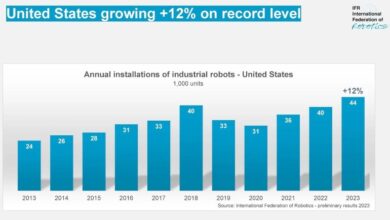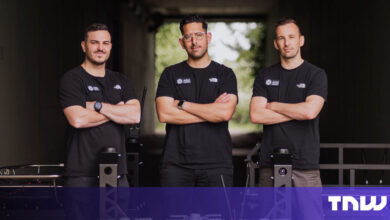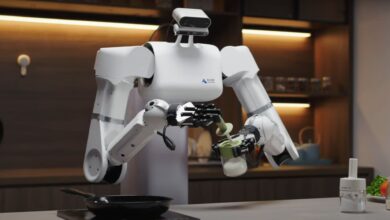CMU, NASA JPL collaborate to make EELS snake robot to explore distant oceans

|
Listen to this article |

Version 1.0 of the EELS robot during field testing in Alberta, Canada, in September 2023. | Source: NASA/JPL-Caltech
In a collaboration that was 17 years in the making, Carnegie Mellon University, or CMU, researchers worked with NASA Jet Propulsion Laboratory to create an autonomous snake-like robot. The Exobiology Extant Life Surveyor, or EELS, is a self-propelled robot. NASA scientists said they hope to use EELS to search for signs of life in the ocean beneath the icy crust of Saturn’s Enceladus moon.
EELS was developed at NASA’s JPL with collaboration from Carnegie Mellon, Arizona State University, and the University of California, San Diego. Howie Choset, CMU’s Kavčić-Moura Professor of Computer Science in the School of Computer Science, Matt Travers, a senior systems scientist at the school’s Robotics Institute (RI), and Andrew Orekhov, a project scientist in the RI, contributed to the project.
The resulting robot can navigate extreme terrains, including ice, sand, rocks, cliff walls, deep craters, underground lava tubes, and glaciers. The CMU team developed the controllers for the robot. In addition, an early prototype used modules developed by HEBI Robotics, a university spinout that Choset founded in 2014.
“Enceladus is essentially covered with water,” Choset told The Robot Report. “But it’s underneath the rock that forms the moon. In the South Pole, the rock and ice are about 2 km [1.2 mi.] thick, and there are geysers that spit the water out from the underground ocean into space. So, there’s a belief that if you fly a spacecraft to Enceladus, land, and then get into the geysers, you may be able to swim in this extraterrestrial ocean.”
EELS snake robot built for space applications
“So, we’ve been working on snake robots for a very long time,” Choset said. “And what’s nice about snake robots in general, is they can use their many joints and their slender physique to thread through tightly packed volumes and get to locations that people in machinery otherwise can’t access.”
This makes snake robots good for many applications, including search and rescue, he said. In this case, EELS will use these capabilities to wriggle into cracks in Enceladus’ layer of ice. EELS stands out from other snake robots because of its “wheels.” These wheels look more like corkscrews than traditional wheels, said Choset.
“When those corkscrews rotate, they kind of penetrate the ice a little bit, but also gives the mechanism the ability to roll forward,” he explained. “So the robot has the ability to propel itself, not only with the snake-like motion but also these corkscrew wheels that allow it to traverse icy surfaces really quickly.”
Choset said these wheels will help the robot to better move across ice until it can find a crack or geyser hole to crawl into.
“The autonomy that we developed is the robot’s ability to get into a tight space, and then use the constraints of that tight space to propel itself forward,” he said.
But that’s only half of the battle. Once the EELS robot has found its way into one of these holes, it has to be able to swim through Enceladus’ ocean to search for potential signs of life. Choset’s team already had experience building swimming snake robots.
“We built a variety of snake robots, but the one we most recently built was a swimming one called HUMRS, which stands for ‘Hardened Underwater Modular Robot Snake,’” Choset said. The CMU team was able to apply what it learned while developing HUMRS to this project with NASA JPL.
Connections bring the right people on board
Choset’s long-held connections within the industry brought him onto the EELS project, along with his expertise in designing snake-like robots.
“I went to Caltech as a graduate student, and JPL was part of Caltech,” he said. “So, whenever there’s an opportunity to work with JPL, the Jet Propulsion Lab, I jump on it, because it reminds me of my young graduate student days.”
It wasn’t just the chance to work with JPL that brought Choset on board, however. He was recruited by Rohan Thakkar, a researcher who worked in Choset’s group 17 years ago as a high school student.
“I think it’s important for people to realize that it’s not just a bunch of engineers getting together to build some mechanism as if they’re reading from a recipe or a cookbook,” Choset said. “Engineering is very important, but I want people to recognize the engineers behind the engineering.”
Choset said that personal connections, like the one between him and his CMU students, are what keeps the industry running.
Editor’s note: HEBI Robots will exhibit at Booth 448-12 at the Robotics Summit & Expo, which will be on May 1 and 2 at the Boston Convention and Exhibition Center. Registration is now open.
 Learn from Agility Robotics, Amazon, Disney, Teradyne and many more.
Learn from Agility Robotics, Amazon, Disney, Teradyne and many more.



